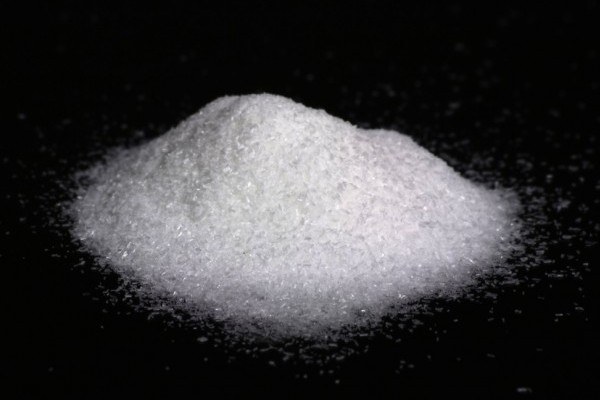Tip 1: How to get sodium aluminate
Tip 1: How to get sodium aluminate
Aluminate sodium - a chemical compound having the formula NaAlO2. It is widely used for wastewater treatment (industrial and municipal), due to its high efficiency and relatively low cost. It is also used in the cosmetic, paper, leather industry, in the manufacture of molecular sieves, titanium dyes and some polymers. How can I get aluminate sodium?

You will need
- - Rector of stainless steel with a stirrer and a "steam jacket";
- - a solution of sodium hydroxide;
- - aluminum hydroxide;
- - receiving capacity;
- - filters.
Instructions
1
The main industrial method for obtaining the substance is aluminate sodium - reaction of newly formed aluminum hydroxide Al (OH) 3 with a hot solution of caustic soda NaOH.
2
To do this, load the required amount of caustic solution into the reactor sodium, then with mixing begin to addaluminum hydroxide, do it slowly. Simultaneously, passing steam through the so-called "shirt" of the reactor, bring the temperature of the reaction zone to a value close to the boiling point of sodium hydroxide.
3
After the end of the reaction, the resulting mixturethoroughly cool and filter. If necessary, repeat the filtration several times, do this until a clear, clear liquid is obtained. This is the solution of aluminate sodium. The resulting product must be stored at a temperature not lower than twenty degrees (otherwise aluminum hydroxide precipitates as a precipitate).
4
The reaction can be simplified in the following form: Al (OH) 3 + NaOH = NaAlO2 + 2H2O.
5
It should be remembered that an aqueous solution of aluminate sodium is stable only in alkaline medium, therefore the amount of hydroxide sodium always should be taken with some excess.
6
With this method, a liquid product is obtained. But sometimes it is necessary to get aluminate sodium in solid form. For example, if it is used in construction, when added to concrete, that is, to accelerate its solidification. Then you need to use other methods. For example, you can get this product by fusing alumina with Al2O3 oxide sodium Na2O at elevated temperature. The reaction proceeds according to the following scheme: Al2O3 + Na2O = 2NaAlO2.
Tip 2: How to get sodium hypochlorite
Hypochlorite sodium - a chemical compound having the formula NaOCl. This is the sodium salt of hypochlorous acid. The substance is very unstable, therefore it is used in the form of pentahydrate: NaOClx5H2O. An aqueous solution of this salt is known under the name "Labarrakov water" and has a strong smell of chlorine. Used (and continues to be used) as a bleach, bactericidal and disinfectant reagent, and also in some chemical processes, as an oxidizing agent. How can I get hypochlorite sodium?

You will need
- - an aqueous solution of calcium hypochlorite Ca (OCl) 2;
- - an aqueous solution of sodium carbonate (soda ash) Na (CO3) 2;
- - balloon with chlorine;
- - a reaction vessel with a saturated solution of sodium hydroxide;
- - a container with a lot of ice, or a regular refrigerator;
- - low-temperature refrigerator;
- - a glass funnel with a filter;
- - thermometer;
- - plastic hose connected to the cylinder reducer.
Instructions
1
The bleaching properties of chlorine were discovered at the end of the 18th century, when experiments were carried out to dissolve this halogen gas in water. Subsequently, chlorine was passed through the hydroxide sodium, with the formation of a solution of the NaOCl salt, called "Labarrak water" - in honor of the scientist A. Labarrak, who proposed this method. You can use the same method of Laparraca.
2
Place the reaction vessel in an ice vessel, immerse it in a solution of hydroxide sodium the tip of the plastic hose, unscrew the valve of the reducer, adjusting it so that "bubbling" the hydroxide solution sodium was noticeable, but rather weak. Wait a few minutes. During this time the reaction will pass: Cl2 + 2NaOH = NaOCl + NaCl + H2O.
3
Wrap the valve, remove the hose from the solution,Continue cooling (in an ice vessel or by placing a container in a regular refrigerator). Wait until the mixture temperature is 0 degrees. In this case, chloride sodium will precipitate in the form of small crystals. Separate this salt with a funnel and a paper filter. The solution is placed in a low-temperature refrigerator, setting the temperature at -40 degrees. Soak for at least 1 hour, then bring to a temperature of -5 degrees. Crystals of hypochlorite pentahydrate are formed sodium NaOClx5H2O.
4
But this is a long way, besides,use poisonous chlorine. Therefore, in laboratory practice it is better to resort to another method. The method is based on the fact that the reaction will go to the end if one of its products leaves the reaction zone in the form of gas or precipitate. And the resulting calcium carbonate is a sparingly soluble substance precipitating: Ca (OCl) 2 + Na (CO3) 2 = CaCO3 + 2 NaOCl.
5
Mix both solutions. The precipitate that precipitates is separated by filtration, in solution is hypochlorite sodium.
Tip 3: How to use sodium gluconate
Sodium glukonate (E576) is a nutritional supplement, an acidity regulator designed to enhance gustatory sensations. A similar effect appears due to an increase in the sensitivity of the receptors of the tongue.

What is sodium gluconate
Sodium gluconate is aregulator of acidity, as well as a synergist of antioxidants. It has the appearance of a white crystalline powder that dissolves well in cold water, alkalis, acids and does not dissolve in alcohols. The natural source of sodium gluconate is gluconic acid, which is the product of the first glucose oxidation.Synergists of antioxidants are substances that enhance the action of antioxidants.According to SanPiN 2.3.2.1078-01, food supplement sodium gluconate (E576) is included in the list of substances that do not have harmful effects on the human body. In accordance with the Decree of the Russian Federation No. 36 of 14.11.2001 of the Chief Sanitary Doctor, the harm of this food additive is not determined. However, in a large amount of sodium gluconate can cause "Chinese restaurant syndrome" - a complex of bodily sensations, which are expressed by red face, increased sweating, palpitations, headache. The recommended norm of this food additive is no more than 20 grams per day.
Where is sodium gluconate applied
Gluconate sodium can bind excess calcium,iron and heavy metal ions, and is therefore widely used in the food industry. It is also used as a component of industrial detergents. Due to the combination of complexing, dispersing, anticorrosive properties, stability in strongly alkaline medium and good solubility, sodium gluconate is a remarkable complexing agent for creating alkaline cultures. Detergents containing sodium gluconate are used in the dairy and glass industries, as well as in the beer industry as descaling agents.In the production of steel, the use of sodium gluconate helps to improve the state of metals, it prevents the deposition of salts on their surfaces.Washing of tare and equipment with solutions,containing sulfamic acid and sodium gluconate, eliminates traces of mineral and organic deposits on the surfaces, prevents accumulation of calcium. This substance is added to cement in the oil industry as an additive, as well as in a solution for processing production wells. Sodium gluconate is used in metallurgy as a chelating agent that binds metal ions together and makes it easy to remove the precipitate during filtration.
Tip 4: Sulfacil sodium: instructions for use
Sulfacil sodium is an antibacteriala medicinal preparation for topical use, available as eye drops. The drug is used in ophthalmology for the treatment of infectious and inflammatory eye diseases: purulent and ulcerative lesions of the cornea, blepharitis, conjunctivitis and gonorrheal diseases of the eyes. Also, sodium sulfacil is used to prevent blenorrhea in newborns.

Instructions
1
Before using sodium sulfacil,tightly tighten the cap on the vial, and before the first use it must be screwed up to the stop. On the inside of the cap there is a spike, which pierces the hole necessary for the use of the preparation. Before using the bottle with droplets, it is recommended to hold it in your palm for a while, to heat the drug to body temperature. Then it is necessary to unscrew the cap and drip the solution into the eyes, lightly pressing on the soft body of the vial. After applying the drug cap tightly screwed.
2
For the treatment of adult patients, 10-30%solution of sodium sulfacyl. The drug must be instilled in the conjunctival eye bag. Recommended dosage for sulfacil sodium dosage for adults - 1-3 drops in each eye 3 to 6 times a day. In the treatment of children, a 10-20% solution of the drug is used and the following dosage: 1-2 drops in each eye 3 to 5 times a day. The timing of treatment depends on the severity of the disease. In order to prevent blenearitis, 2 drops of sodium sulfacyl are injected into each eye immediately after birth, and 2 hours later the instillation is repeated using the same dose.
3
Sulfacil sodium is not used with increasedsensitivity to sulfacetamide, as well as other sulfanilamide drugs. The remedy is allowed to use during pregnancy and breastfeeding after consulting a doctor. When using the drug should be considered that it is incompatible with drugs containing silver salts and zinc sulfate. In addition, there are medicines that increase the toxicity of sodium sulfacyl. These include salicylates and paraaminosalicylic acid. Some drugs (anesthesin, dicaine and novocaine) are able to reduce the bacteriostatic effect of sodium sulfacyl.
4
Side effects of sodium sulfacil maymanifest in the form of redness, itching and swelling of the eyelids. As a rule, they are observed with frequent or too long use of the drug. If these side effects occur, the treatment can be reversed or continued with a lower concentration of sodium sulfacyl solution. It should be taken into account that patients with hypersensitivity to thiazide diuretics, carbonic anhydrase inhibitors and sulfonylurea derivatives may have increased sensitivity to sodium sulfacyl.
Tip 5: Sodium silicate: properties and applications
Silicate of sodium is one of the salts of siliconacid, known as liquid glass. It was first obtained by the German chemist Jan Nepomuk von Fuchs in 1818. Since then, scientists have used it for the needs of the food industry.








